#unfair that its gimmick never got reused
Explore tagged Tumblr posts
Text
I Liked Fates Before It Was Cool!: Conquest Part 1
Prologue
Opening Chapters
Chapters 6-14, in which if you squint really hard there might be a plot in there somewhere.
Chapter 6
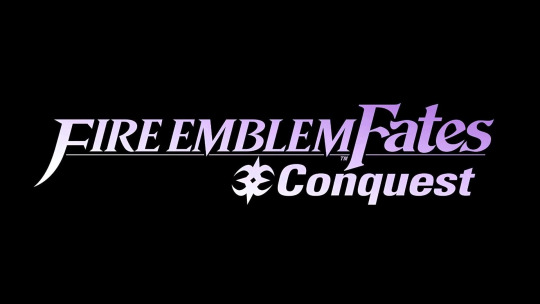
But let’s not be unfair right from the start. Conquest offers what I consider the best version of Chapter 6, both as a narrative introduction to the route and as a gameplay challenge fitting the difficulty of what’s to come. Birthright is basically just Ryoma soloing Xander and Revelation throws you against generics, but here you have to make use of all the Nohr royals to defeat all but one unit on the Hoshidan side - and being able to take care of Ryoma quickly enough nets you a prize of sorts in that you don’t have to beat up an unarmed Sakura. The chapter also sets up the tense undercurrent of Conquest that Corrin chose wrong, that the Hoshidans (except Takumi) think they’ve been brainwashed and that their love for their adopted siblings is meaningless. On the one hand it feels rather spineless that what is supposedly a villain campaign is hesitant to allow Corrin to own their choice and makes it sound like blatant railroading by the player, but on the other there’s something to be said for the contrast between how Xander and Ryoma deal with Corrin’s decision. After two refusals in Birthright Xander is happy to label Corrin a traitor and becomes determined to kill them for their choice, whereas Ryoma persists in his brainwashing theory and in so doing denies Corrin’s agency completely. That actually works fairly well as setup for an antagonist - if we allow that Ryoma is one, of course, and the game itself seems uncomfortable with the concept.
Chapter 7
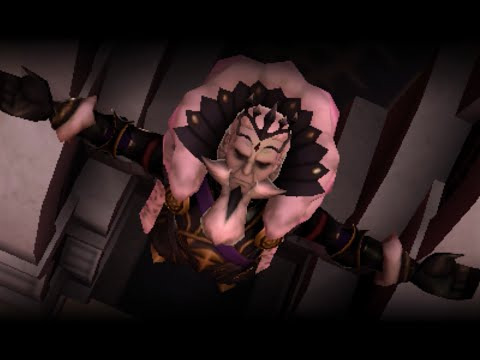
...And all my goodwill toward this story dries up almost immediately. There’s flat villainy, there’s a bunch of self-doubt from Corrin over their choice, and there’s foreshadowing that only adds to the confusion if you already know what’s going on. It’s kind of a mess, and it’s pretty much all downhill from here.
I have little to say about this chapter as it stands, except that it’s appropriately difficult and that the conflict feels fitting in terms of tone and atmosphere...even though it only exists because of the aforementioned flat villainy. I instead want to zero in on the moment pictured above, in which Garon “prays” to Anankos to deliver unto him the plot of the next few chapters in front of Corrin and Iago and the Nohr royals. Bizarrely, it’s Iago who goes furthest in calling Garon out on how absurd this is, though not even he bothers to ask who or what Anankos is or if he’s the same entity as Nohr’s Dusk Dragon.
Ok, I know I might be the only person in the fandom who regularly complains about the absence of pseudo-Catholic elements in Fates when they’re present in every other game in the series, but on a fundamental level I do get it. The priest -> sage/war monk class line from Awakening was given to Hoshido, so it makes perfect sense that those classes would be shifted over to the blend of Shintoism and Buddhism that comprises Japanese spirituality. It’s also not unheard of for a nation or group of people in FE to worship a dark dragon/god in lieu of the main organized faith, ex. the Lopytrians from Jugdral, Rigel’s Duma Faithful, and Plegia’s Grimleal. As seen with Salem from FE5 and Tharja and Henry from 13 it’s even fairly common for playable dark magic users in the games to come from the ranks of those faiths. I therefore don’t have a problem with the theory that there’s a theological element to Nohr’s dark mages and that it ties into the Dusk Dragon - who may or may not also be Anankos - in some way. The problem is that we never see any definitive evidence that this is the case, not even enough to understand how unusual it is in this scene to see Garon praying to Anankos. When Iago sounds like the closest thing to a voice of a reason you know the plot’s got some problems. For all we’re told Nohr’s clergy are just bookworms moonlighting as strippers with a crow feather fetish.
Chapter 8
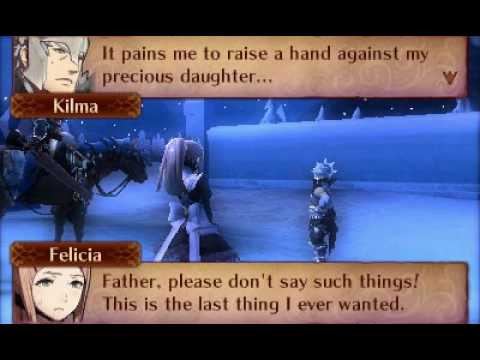
It’s strange how easy it is to forget this guy exists since he only appears in Conquest in this one chapter, but the Ice Tribe maids do indeed have a father. Where was he during Chapter 17 of Birthright?
This brings up an interesting - or as some would probably call it, lazy - quirk of Fates’s map design. The early and midgame sections of all three routes are full of maps that get reused across routes, or different maps of the same location like the previous one and Birthright Chapter 18. I’m feeling rather charitable about this decision personally, for two reasons:
1) In most cases the reused maps are approached from different angles and feature different, sometimes opposing gimmicks. The Ice Tribe village map, for example, sees you racing to visit as many villages as possible in Conquest but encourages you to avoid them in Birthright, and the function of the Dragon Veins in the middle of the route differs depending on the route.
2) Fates’s worldbuilding needs all the help it can get, and visiting the same locations in multiple routes adds a degree of continuity that the story on its own often struggles to display.
See, cost-cutting measures don’t have to be a bad thing if you use them creatively!
This chapter also deserves some praise for having a more plausible point of conflict than its Wind Tribe counterpart in Birthright. Instead of Iago’s shenanigans Elise grabs the conflict ball because no one taught her basic diplomacy, and Corrin saves the day through their first of many acts of pacifism on this route. It is a bit strange to have the characters talking about how Corrin’s army spared everyone just after you’ve finished mowing down a bunch of generics, but not unlike Niles I can use my imagination.
Chapter 9

A wild loli appears! Ugh...Nyx is one of several characters in Fates who could have been interesting with better execution. As it is, her best use is as a punchline or somebody’s fap material of course.
This chapter has nothing to do with her though really. Instead it’s just a set of contrivances - how did a Hoshidan force make it so deeply into Nohr so quickly (for comparison, Corrin’s army reaches the same location in Birthright by Chapter 20), and why did they bring Azura all this way with them if their only plan was to kill her? I do appreciate the reminder that Nohr and Hoshido are actually at war now as the rest of the Conquest’s early plot is more concerned with putting down rebellions, but some kind of logical reason for Azura’s reappearance would have been nice.
Still, this chapter goes further than most at showing an explicit example of Hoshidan racism, even if Azura is quick to absolve the royals (except Takumi, I assume) of any wrongdoing. I genuinely have no idea if we’re meant to interpret this as Stockholm Syndrome, or if the writers couldn’t bear to vilify all of Hoshido even for one chapter.
Chapter 10

Like a number of other defense maps in the series, this is the most infamous chapter of its game, and depending on who you’re using and how it can indeed live up to its reputation. I don’t care for how this makes for an uneven bump in Conquest’s difficulty curve, but with such varied chapter goals and mechanics on this route that was likely inevitable at some point.
For all that it’s a memorable piece of gameplay though there’s not too much to talk about in terms of story. Takumi is established as a strong and motivated antagonist right from his first reappearance after the route split, and as I said back in Birthright it’s a good look for him. He and Oboro are among the few Hoshidans who really make more sense as antagonists than as allies, and even though it devolves into yet another round of possession in the end there’s something very real to Takumi’s feelings of betrayal and inadequacy, to say nothing of his grief over his mother which unlike in Birthright barely comes up otherwise.
Also, Camilla is here, but with only a bit of retainer banter to flesh her out she’s more or less the same as FE10 Haar in Chapter 2-E of that game: overleveled flying death, with only a few stray bits of effective damage to worry about.
Chapter 11

The Sevenfold Sanctuary appears again, this time with tricky skill combos to contend with like archers with Counter and ninjas with Lunge as well as more of the by now common enemy pair-ups and a boss with an unfair enemy-only weapon. Does anyone else find it strange just how many such weapons exist in Fates?
In this route it’s the Hoshidans who get to troll Corrin, dragging the Rainbow Sage up Mount Sagesse for no real reason and doing their best to not sound like they’re invading a sovereign territory and kidnapping its most venerable inhabitant who also happens to be an ancient dragon. Granted the Nohrians’ mission feels a bit confused as well, as dialogue vacillates between Garon wanting to conquer Notre Sagesse and everyone else wanting the Rainbow Sage’s power. The two sort of come together in the end with Iago ordering the Sage’s death, though if there’s a logical explanation for Garon/Anankos’s continued desire to see Corrin suffer but not die it’s beyond me. That Corrin gets an eventual sword power-up out of the deal feels almost accidental on this route.
Incidentally, while he doesn’t get the gravity of a potential death scene in this version I do like how Kaze joins up with the Nohrians. It conveys the subtext of his connection to Corrin while not coming across as a weird obsession like his approximate counterpart Silas does in Birthright. Speaking of which, I’ve noticed that Silas gets a decent amount of the protagonist chorus roles in Conquest even when some of the royals are available. Eh...they are supposed to be BFFs.
Chapter 12
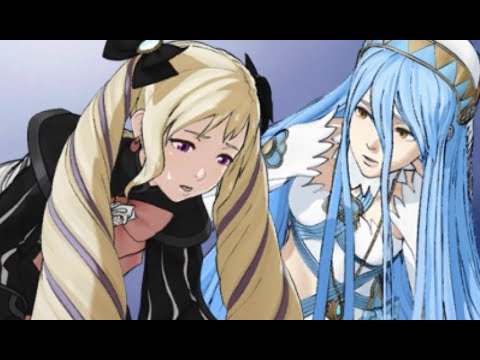
Now that’s just not as funny as the version of this picture with Takumi.
Elise comes down with a case of the plot, and as a consequence we bear witness to Ryoma’s most infamous act of dickishly non-heroic behavior. I’ve seen it argued back and forth that Ryoma withholding medicine from Elise in an attempt to coerce Corrin into returning to Hoshido constitutes a war crime, but regardless of semantics it is a surprisingly underhanded tactic for someone like him. Now that I think about it Birthright shows off this side of him as well, when he disguises himself as a Nohrian soldier at Cheve to ambush Leo. Not exactly becoming a shining exemplar of heroism here awkwardly forced into the antagonist role...but then he goes off about how his retainers have a more righteous cause than Xander’s and suddenly I lose what little sympathy I had for him. Sure, one of the retainers he’s insulted is Peri, but on the whole that’s an eminently hateable level of self-righteous posturing.
This chapter is quite fun, if a bit chaotic with all the random effects from the pots. For some reason I always forget about the turn limit, which can become an unexpected source of stress when there are shrine maidens spamming status staves to slow you down and such. Fates (and Conquest specifically) is the one game other than Thracia that frequently turns enemy staff wielders into serious threats, and this chapter combined with Azama’s Hexing Rod in the previous one show that off thoroughly.
Chapter 13
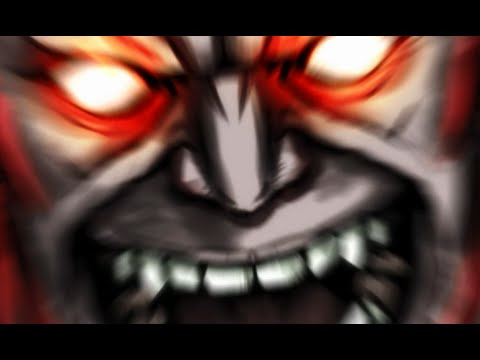
Pictured: a subtle and nuanced depiction of villainy.
Aside from his sudden reappearance and this one still, Hans is actually...not that bad here though? Corrin points out how weird it is that they (and the player) are expected to forgive him after he attempted to kill Corrin at the Bottomless Canyon, and the worst atrocities of Hans’s army - particularly Scarlet’s death - are effectively gruesome because they’re left for the player to imagine. It’s comparable to how FE8 handles the ghastly presence of Orson’s wife. It is pretty silly how much is made over Hans clearly enjoying his work when Peri was recruited in the last chapter and Reina is also in this game (in this chapter, even), or that explicit bloodlust among the playable cast has shown up before in past FEs in characters like FE7 Karel. Player-centered morality, yay!
In any case, there’s also a good deal of genuine character complexity on display in this chapter too. Takumi is still consumed by grief and rage and lashes out specifically at the bond Corrin shares with the Nohrian sisters, calling attention to his increasing isolation from even his own siblings. Between taking an arrow in a cutscene and last chapter’s illness Elise just can’t catch a break, can she? Camilla too gets to show a rare bit of character for this route, encouraging Corrin to keep their head down and go along with Garon’s orders because self-centered pragmatism is how she’s learned to survive in situations where she can’t solve problems with violence and/or sex.
Chapter 14

What an incredibly effective disguise. No one would ever recognize her.
Ok, ok, the audience at the opera is seeing her from a distance and obscured by all the water effects, but it’s still pretty dumb that Corrin of all people can’t put two and two together here.
Honestly, as much as I enjoy the opera house setting and praised its appearance in Birthright this chapter all falls into that same generally silly vein. There’s again no logical explanation provided for Garon’s trip to Nestra, the enemy combatants on this map are a random squad of Hoshidans unrelated to the unfolding story, Keaton’s recruitment has even less buildup than Kaden’s did, and everything culminates in Leo teaching Corrin the obscure and arcane art of lying and in so doing bequeathing him with a sword upgrade because that’s what passes for (anti)heroism on this route. There’s not even much in the way of gameplay to discuss, which is disappointing when contrasted against the Birthright version.
I would however like to close this post by reiterating the point I made at the start: so far, this route is severely lacking in an actual plot. All of Corrin’s movements since returning to Nohr have been directed by Garon (and Anankos by extension, though his motives remain vague even if you know the full story). In a way this helps to reinforce the feeling that the Nohrian royals are trapped in abusive situation, though that would be an unusually deep psychological reading of what is in reality an unfocused plot. The following chapter and what comes of it ought to be proof enough that any similarities between Conquest’s narrative structure and the familial issues of its main cast are purely coincidental.
Next time: Conquest Chapter 15 - 20
6 notes
·
View notes